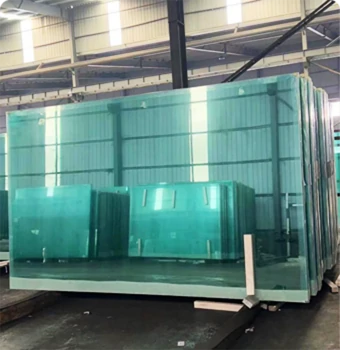The Difference Between Tempered Glass and Normal Glass
When it comes to choosing the right type of glass for various applications, understanding the differences between tempered glass and normal (or annealed) glass is essential. Each type of glass has unique properties that make it suitable for specific uses, and knowing these differences can help consumers make informed decisions.
1. Definition
Normal glass, also known as annealed glass, is the standard type of glass that is produced through a basic melting and cooling process. It is relatively easy to manufacture but has a limited ability to endure stress and impact. On the other hand, tempered glass undergoes a rigorous heating and cooling process, known as tempering. This process increases the glass's strength and durability, making it significantly more resistant to thermal and physical stress compared to normal glass.
2. Strength and Durability
One of the most significant differences between tempered glass and normal glass lies in their strength. Tempered glass is about five to six times stronger than standard glass of the same thickness. This strength is crucial in high-stress situations, such as in buildings, shower doors, and car windows. In contrast, normal glass can easily break or shatter upon impact, which makes it unsuitable for situations where safety is a priority.
3. Safety Features
In terms of safety, tempered glass is designed to break into small, blunt pieces rather than sharp shards, reducing the risk of injury. This characteristic makes it the preferred choice for applications such as glass doors, skylights, and facades where safety is a concern. Normal glass, however, can shatter into dangerous sharp fragments, increasing the risk of cuts and injuries.
what is the difference between tempered glass and normal glass
4. Temperature Resistance
Tempered glass also exhibits higher temperature resistance compared to normal glass. It can withstand temperature fluctuations without breaking or warping. This feature makes it an ideal choice for applications that involve high heat, such as in oven doors or glass cooktops. Normal glass, by contrast, can fracture or break when exposed to sudden temperature changes, making it less reliable for heat-sensitive environments.
5. Manufacturing Process
The manufacturing processes for both types of glass differ significantly. The production of normal glass is relatively straightforward, involving the melting of silica sand, soda ash, and limestone. After forming, it is slowly cooled in a controlled environment. Conversely, the tempering process involves heating the glass to around 620 degrees Celsius (1,148 degrees Fahrenheit) and then rapidly cooling it. This tempering process creates internal compressive stress that contributes to the enhanced strength of the glass.
6. Applications
Given their differences, tempered glass is commonly used in a variety of applications where strength and safety are critical. These include automotive windows, shower bases, facades, and glass doors. Normal glass, while still used in many areas, is more often found in applications where safety and impact resistance are less of a concern, such as in picture frames or decorative items.
In conclusion, the choice between tempered glass and normal glass depends on the specific requirements of the application. While normal glass is suitable for general use, tempered glass offers enhanced strength, durability, and safety features, making it indispensable in high-risk environments. Understanding these differences is crucial for selecting the right product for your needs.
 Afrikaans
Afrikaans  Albanian
Albanian  Amharic
Amharic  Arabic
Arabic  Armenian
Armenian  Azerbaijani
Azerbaijani  Basque
Basque  Belarusian
Belarusian  Bengali
Bengali  Bosnian
Bosnian  Bulgarian
Bulgarian  Catalan
Catalan  Cebuano
Cebuano  Corsican
Corsican  Croatian
Croatian  Czech
Czech  Danish
Danish  Dutch
Dutch  English
English  Esperanto
Esperanto  Estonian
Estonian  Finnish
Finnish  French
French  Frisian
Frisian  Galician
Galician  Georgian
Georgian  German
German  Greek
Greek  Gujarati
Gujarati  Haitian Creole
Haitian Creole  hausa
hausa  hawaiian
hawaiian  Hebrew
Hebrew  Hindi
Hindi  Miao
Miao  Hungarian
Hungarian  Icelandic
Icelandic  igbo
igbo  Indonesian
Indonesian  irish
irish  Italian
Italian  Japanese
Japanese  Javanese
Javanese  Kannada
Kannada  kazakh
kazakh  Khmer
Khmer  Rwandese
Rwandese  Korean
Korean  Kurdish
Kurdish  Kyrgyz
Kyrgyz  Lao
Lao  Latin
Latin  Latvian
Latvian  Lithuanian
Lithuanian  Luxembourgish
Luxembourgish  Macedonian
Macedonian  Malgashi
Malgashi  Malay
Malay  Malayalam
Malayalam  Maltese
Maltese  Maori
Maori  Marathi
Marathi  Mongolian
Mongolian  Myanmar
Myanmar  Nepali
Nepali  Norwegian
Norwegian  Norwegian
Norwegian  Occitan
Occitan  Pashto
Pashto  Persian
Persian  Polish
Polish  Portuguese
Portuguese  Punjabi
Punjabi  Romanian
Romanian  Russian
Russian  Samoan
Samoan  Scottish Gaelic
Scottish Gaelic  Serbian
Serbian  Sesotho
Sesotho  Shona
Shona  Sindhi
Sindhi  Sinhala
Sinhala  Slovak
Slovak  Slovenian
Slovenian  Somali
Somali  Spanish
Spanish  Sundanese
Sundanese  Swahili
Swahili  Swedish
Swedish  Tagalog
Tagalog  Tajik
Tajik  Tamil
Tamil  Tatar
Tatar  Telugu
Telugu  Thai
Thai  Turkish
Turkish  Turkmen
Turkmen  Ukrainian
Ukrainian  Urdu
Urdu  Uighur
Uighur  Uzbek
Uzbek  Vietnamese
Vietnamese  Welsh
Welsh  Bantu
Bantu  Yiddish
Yiddish  Yoruba
Yoruba  Zulu
Zulu 

